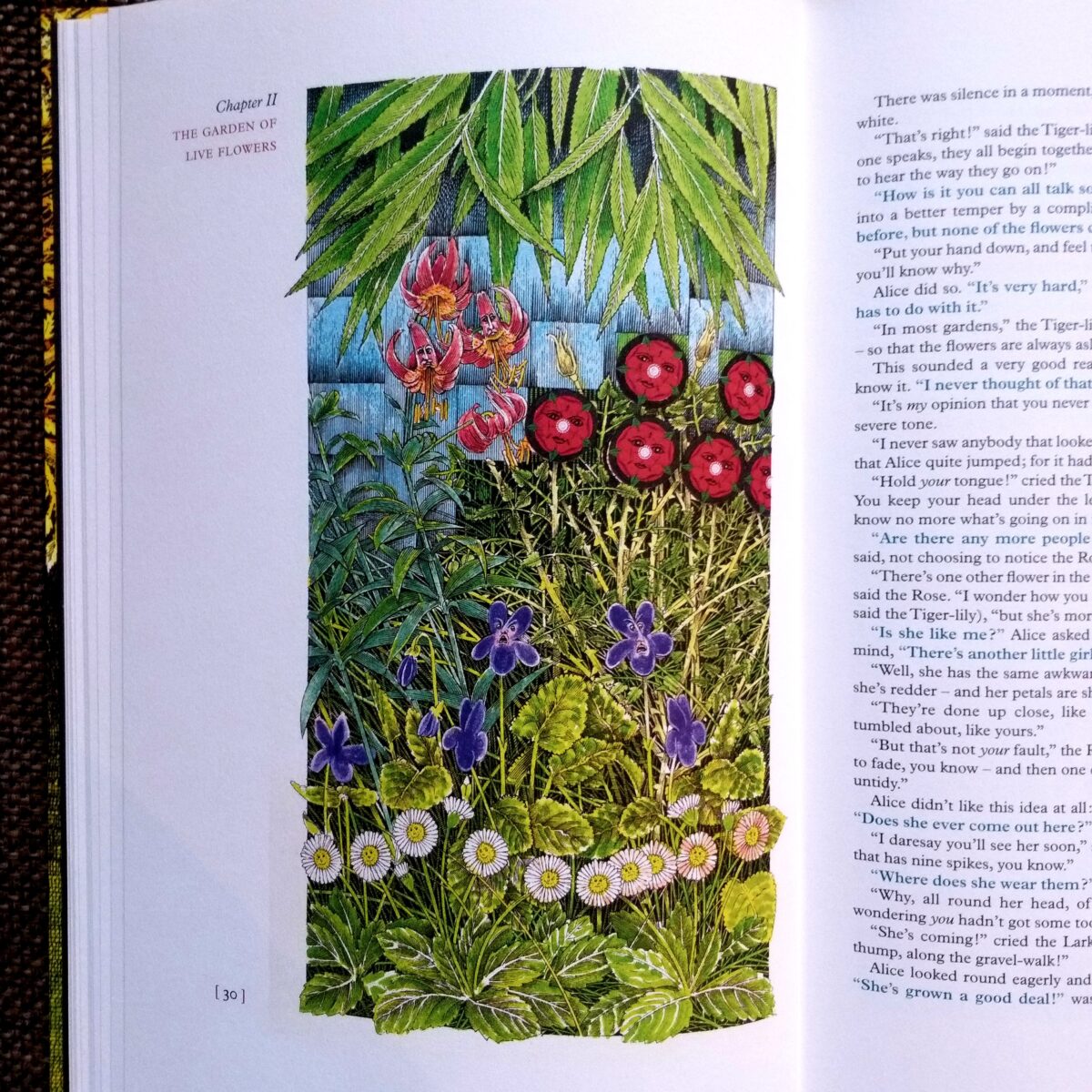“Looking-Glass is a brilliant sequel – it is not a return of Wonderland but rather a more satisfying further adventure.” Dr. Selwyn Goodacre
Though I dearly love every single ‘Alice’ in my home library, John Vernon Lord’s visual interpretation is amongst my favourite. A great way of getting to know any book is, to begin with its creator’s notes in the introduction or afterword, especially when the creator is John Vernon Lord who gives his readers such an insightful peek behind the curtain of his working process and thinking. In the Afterword, to this magnificent edition, John Lord notes that:
There is hardly anything new to be said about Lewis Carroll’s two ‘Alice’ books. So much has been written about them. Their contents have been probed by the scalpels of psychoanalysts, literary theorists, annotators, enthusiasts and journalists. Perhaps I should include illustrators among this group, for it is the illustrator’s duty to get to grips with the text and thus make a visual commentary upon it. Readers of the text and viewers of the illustrations also make a book their own. Each one of us interprets stories and pictures in our own way and each one of us is unique.
The foreword in this book, by a renowned Carrollian luminary Dr Selwyn Goodacre, is equally insightful. Something to admire before you follow Alice through the looking-glass is the luxuriously thick paper called Mohawk cool-white to whom it matters. Not only is its tone and texture a joy to the eye and tantalising to the touch, but it emanates a delicate scent as aromatic as your favourite signature perfume.

Alice’s part in all dialogues is set in a blue font which stands out from the rest of the text. The first letter of each chapter looks like an illuminated initial from a medieval manuscript. Nothing is left to chance in this edition, every single detail has been perfectly considered.
Alice herself is rarely illustrated on the page, but we are instead invited to marvel at Wonderland and all its majesty through her eyes and imagination, making us (the reader) feel like we are Alice.
“Small is beautiful, so is black and white”, says the artist in his eloquent afterword. John Vernon Lord’s illustrations are inventive and masterful, both complex and cohesive. What I like best is their balance. Realism balanced with abstraction, colour with greyscale or tonal drawings. Large stand-alone plates alternate with small in-text pictures and vignettes. A variety of illustrative techniques have been employed from painted images and elements of photographic collage to what appears as woodcut prints and lithographs. The latter are reminiscent of Escher’s lithographs with their mathematically inspired illusions. John Vernon Lord’s play with styles, techniques and colors appears to mirror the wordplay and unpredictability of the story and the Wonderland itself. He is without doubt one of the most innovative illustrators around.
This state-of-the-art production of “Through the Looking-Glass” is number 324 from the limited edition of 420 published by Artists’ Choice Editions in 2011, signed by the artist. 98 of the 420 total edition print run were Specials including the a selection of prints. One of the prints was an illustration for the chapter “The Wasp in a Wig” which has been omitted from the publication, partly due to John Tenniel’s reluctance to illustrate it, it seems (read more about this in John Vernon Lord’s blog post):

Enjoy browsing “Through the Looking-Glass” by John Vernon Lord below.
Author: Lewis Carroll Illustrator: John Vernon Lord Publisher: Artists' Choice Editions Year of publication: 2011 (MMXI) Language: English ISBN: 9780955834318 (standard copy, reviewed above), 9780955834356 (deluxe Special) Published as 420 copies, of which 98 are deluxe Specials (leather-bound, with a special booklet called “Lords’ List” and a selection of prints signed by the artist John Vernon Lord). The Specials are numbered with Roman numerals.
John Vernon Lord has also illustrated “Alice’s Adventures in Wonderland” for Artists’ Choice Editions in 2009, which I have been trying to find for years and finally found a copy. To browse other editions in my collection of illustrated “Alice in Wonderland” click here. To browse other editions in my collection of illustrated “Through the Looking-Glass” click here. What is your favourite illustrated ‘Alice’? I would love to hear your feedback in comments.
Full-page plates

Black and white illustrations
Smaller in-text illustrations and vignettes




My favourite sentient Pudding in my entire “Alice” collection

Frontispiece, chessboard end papers, the beginning
The End






































Marvelous, simply marvelous. Even better than the Alice book
Better than Wonderland? I prefer the sequel from literary perspective so would tend to agree. Though if purely referring to JVL work itself I could never pick a favourite.